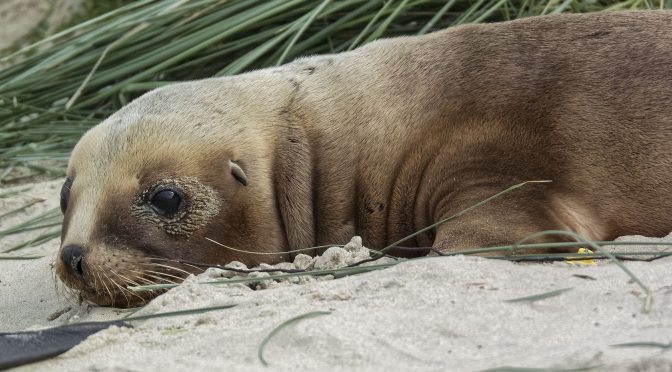This short article features some images of a New Zealand fur seal and its pup, captured hand-held at Surat Bay New Zealand during our month-long March 2018 field trip. While I did photograph a few other specimen that were on this same stretch of beach, this mother and pup at Surat Bay were one of the highlights of our trip.
While we typically kept our hiking into various photography spots to a maximum of about 400 metres (~ 1/4 mile) during most of our trip, we did make an exception on this particular morning. We hiked out about 3-4 kilometres (~1.8 to 2.5 miles) to get to this stretch of beach where we found this mother and pup.
Let’s start with a couple of photographs of the mother fur seal.
NOTE: Click on images to enlarge.

When we first arrived, the mother was having what appeared to be a light snooze on the beach. The pup was behind her in the shade near some shoreline vegetation.

As we drew closer the mother did rise up to have a better look at us. We kept our distance (warning signs on beaches in New Zealand suggest keeping at least 10 metres away from seals and sea lions) and we made sure that we did not get between the mother and her pup.

It didn’t take long for the pup to notice us, and it moved closer in to its mother for a while. We remained quiet and kept our movements slow and measured.

It didn’t take too long before the pup grew comfortable with our presence and watched us with some interest.

The natural inquisitiveness of the pup was obvious, as was its playful nature.

It began watching us while holding its head in various, angled positions.

For a while it decided to observe us while keeping its head in an upside-down position, allowing me to capture a few individual frames of this posture.

The pup did a bit of exploring, always within range of its watchful mother.

I was able to get in a bit closer during the pup’s short exploration away from its mother, which enabled me to capture a few, closer-in photographs.

There is something quite heart-warming being out in nature and being able to capture these types of images of young animals. It is important to be respectful of nature, and to treasure special encounters like the one captured in these images.
Technical Note:
All photographs were captured hand-held in available light using Nikon 1 gear as per the EXIF data. All images were produced from RAW files using my standard process of DxO PhotoLab, CS6 and the Nik Collection.
If you enjoyed this article you may want to have a look at New Zealand Tip-to-Tip. This 250 page eBook features 89 locations in New Zealand and over 400 original photographs. You can use the link to see more detailed information about the eBook. The cost of New Zealand Tip-to-Tip is $12.99 Canadian.
My intent is to keep this photography blog advertising free. If you enjoyed this article and/or my website and would like to support my work you can purchase an eBook, or make a modest $10 donation through PayPal, both are most appreciated. You can use the Donate button below. Larger donations can be made to tom@tomstirr.com through PayPal.
Article and images are Copyright 2018 Thomas Stirr. All rights reserved. No use, duplication or adaptation of any kind is allowed without written consent. If you see this article reproduced anywhere else it is an unauthorized and illegal use. Posting comments on offending web sites and calling out individuals who steal intellectual property is always appreciated!



How cute and that adventure must have been so exciting. Wonderful photos that really show the beauty of their coat.
Hi Joni,
It was a great experience for sure! The pup was cute and very inquisitive.
Tom
Absolutely beautiful and clear image, especially being hand held. Just curious, what is the round yellow disc in the the left flapper? Some kind of electronic trekking device, which would be unusual since these pictures were taken on the open beach. Thank you.
Hi Narendra,
I’m glad you enjoyed the images and thank you for your comment! I believe that the yellow disk on the pup’s flipper is some kind of identification tag. The Government of New Zealand is very concerned about wildlife populations and it has many programs to monitor the size and health of various species. The tag was likely affixed to the pup as part of a biological tracking study. Here is a link to the New Zealand Department of Conservation which you may find of interest: https://www.doc.govt.nz/
Tom